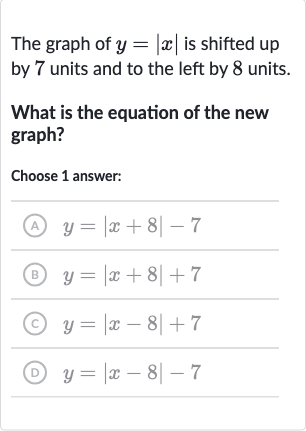Full solution
Q. The graph of is shifted up by units and to the left by units.What is the equation of the new graph?Choose answer:(A) (B) (C) (D)
- Understanding Shifts: To determine the equation of the transformed graph, we need to understand how shifts affect the equation of a function. A vertical shift up by units adds to the value of the function. A horizontal shift to the left by units means we add to the -value inside the function before applying the absolute value.
- Applying Horizontal Shift: Let's apply the horizontal shift first. Shifting the graph to the left by units means we replace with in the absolute value function. The new function becomes .
- Applying Vertical Shift: Now, we apply the vertical shift. Shifting the graph up by units means we add to the entire function. So, the new function after both shifts is .
- Matching the Result: We can now match our result with the given choices. The correct equation after applying both shifts is , which corresponds to choice (B).

